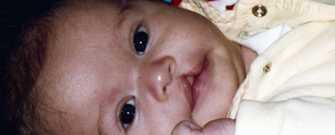Key Findings: Updated National Birth Prevalence Estimates for Selected Birth Defects in the United States, 2004-2006
The Centers for Disease Control and Prevention (CDC) and the National Birth Defects Prevention Network have published a new study updating the national prevalence estimates for selected birth defects in the United States from 2004-2006. You can read the abstract here. The findings from this article are summarized below.

About birth defects and this study:
Birth defects occur in about 3% of all live births. They are also a leading cause of infant death. Timely national estimates of the prevalence of birth defects help us:
- Understand the how many people are affected by birth defects in the United States
- Examine birth defect patterns and trends over time
- Determine if prevention programs are working
- Help communities plan for medical, developmental, and educational services
This CDC study used data from 14 birth defects tracking programs to look at the birth prevalence of birth defects in the United States from 2004-2006. Birth prevalence is the number of babies born with birth defects (including stillbirths and elective terminations) compared to the total number of live births in the population. For this study, researchers took into account maternal age (for Trisomy 13, 21, and 18) and maternal race/ethnicity, which allows state and local programs to use these estimates as a point of reference for comparison with future prevalence estimates. The data from these tracking systems were population-based, which means they looked at all babies born with birth defects who live in the tracking regions.
Main findings from this study include:
- Down syndrome was the most common condition in this study. The estimated national prevalence was 14.47 per 10,000 live births. This means that there are about 6,000 diagnoses of Down syndrome each year in the United States.
- About 7,000 babies are born with a cleft palate, cleft lip or both each year in the United States.
- Common truncus, a type of heart defect, was the least common birth defect in this study. The estimated national prevalence was 0.72 per 10,000 live births. This means that there are about 300 cases of common truncus each year in the United States.
| Birth Defects |
Cases per Births |
Estimated Annual |
Estimated National Prevalence per 10,000 Live Births |
|---|---|---|---|
| Adjusted for maternal race/ethnicity** | |||
| Central nervous system defects | |||
| Anencephaly |
1 in 4,859 |
859 |
2.06 |
| Spina bifida without anencephaly |
1 in 2,858 |
1460 |
3.50 |
| Encephalocele |
1 in 12,235 |
341 |
0.82 |
| Eye defects | |||
| Anophthalmia/ microphthalmia |
1 in 5,349 |
780 |
1.87 |
| Cardiovascular defects | |||
| Common truncus |
1 in 13,876 |
301 |
0.72 |
| Transposition of great arteries |
1 in 3,333 |
1252 |
3.00 |
| Tetralogy of Fallot |
1 in 2,518 |
1657 |
3.97 |
| Atrioventricular septal defect |
1 in 2,122 |
1966 |
4.71 |
| Hypoplastic left heart syndrome |
1 in 4,344 |
960 |
2.30 |
| Orofacial defects | |||
| Cleft palate without cleft lip |
1 in 1,574 |
2651 |
6.35 |
| Cleft lip with and without cleft palate |
1 in 940 |
4437 |
10.63 |
| Gastrointestinal defects | |||
| Esophageal atresia/tracheoesophageal fistula |
1 in 4,608 |
905 |
2.17 |
| Rectal and large intestinal atresia/stenosis |
1 in 2,138 |
1952 |
4.68 |
| Musculoskeletal defects | |||
| Reduction deformity, upper limbs |
1 in 2,869 |
1454 |
3.49 |
| Reduction deformity, lower limbs |
1 in 5,949 |
701 |
1.68 |
| Gastroschisis |
1 in 2,229 |
1871 |
4.49 |
| Omphalocele |
1 in 5,386 |
775 |
1.86 |
| Diaphragmatic hernia |
1 in 3,836 |
1088 |
2.61 |
| Adjusted for maternal age** | |||
| Chromosomal anomalies | |||
| Trisomy 13 |
1 in 7,906 |
528 |
1.26 |
| Trisomy 21 (Down syndrome) |
1 in 691 |
6037 |
14.47 |
| Trisomy 18 |
1 in 3,762 |
1109 |
2.66 |
*The 14 programs included in this table are Arkansas, Arizona, California [8-county Central Valley], Colorado, Georgia [5-county metropolitan Atlanta], Illinois, Iowa, Kentucky, Massachusetts, North Carolina, Oklahoma, Puerto Rico, Texas, and Utah. The number of live births represented by these 14 programs from 2004-2006 was 4,038,506.
**Adjustments are based on United States live birth population, 2004-2006.
More Information
For more information about birth defects, please visit the CDC’s birth defects webpage.
Reference
Parker SE, Mai CT, Canfield MA, Rickard R, Wang Y, Meyer RE, Anderson P, Mason CA, Collins JS, Kirby RS, Correa A; for the National Birth Defects Prevention Network. Updated national birth prevalence estimates for selected birth defects in the United States, 2004-2006. Birth Defects Res A Clin Mol Teratol. 2010 Sep 28. [Epub ahead of print]
- Page last reviewed: October 22, 2014
- Page last updated: October 22, 2014
- Content source:


 ShareCompartir
ShareCompartir